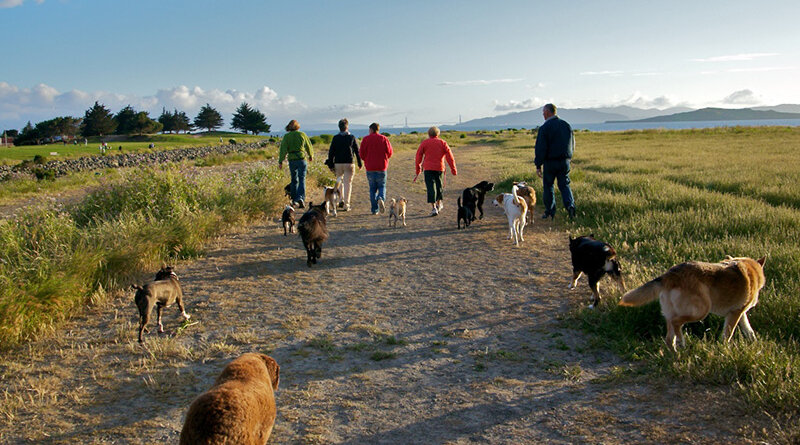Dog Parks Can Be Great Places for Off-Leash Activity
First it was that clickbait title—“Actually, Dog Parks Aren’t All That Great”—that grabbed our attention. Could The New York Times have crafted a slightly less emphatic, all-encompassing headline? As our colleague Marc Bekoff, PhD noted “this is a terribly misleading sensational piece. Of course, all dog parks are not the same and these sorts of over-generalizations are pure fiction … there is no ‘the’ dog park.”
Unfortunately, the article appeared in this week’s New York Times “Smart Living” section and is also highlighted on their home page with an even worse title—“The Dog Park Is Bad, Actually.” While it carries a valuable message (dog parks should have a good deal more self-monitoring than most currently do), its main complaints dominate like the unruly dogs cited in the author’s commentary.
The author, Sassafras Lowrey has written for The Bark, and is a dog trainer based in Portland, OR. Lowrey’s viewpoint is represented in the article tagline: Dog parks may seem like great additions to the community, but they’re rife with problems—for you, and for your dog. A further snapshot of her perspective is the employment of several startling subheads focused on The Socialization Myth, Playground Bullies, Injuries and Diseases. Dangerous places indeed, those dog parks.
As longtime advocates of dog parks we understand the vital role they can play in communities. Certainly, we’ve witnessed firsthand the need for more oversight and the monitoring of dogs who interact and play in these parks. And, yes, the dog community has no shortage of ill-informed, sometimes, clueless people who spend too much time focused on their phones or on other people instead of responsibly paying attention to their dogs. Sure, this neglect does happen at the dog park, but it can also be found at neighborhood tot playgrounds, in line at the local market and just about anywhere people congregate (stop texting and drive!).
GET THE BARK IN YOUR INBOX!
Sign up for our newsletter and stay in the know.
But we take issue of the tone and heavy-handedness of this article—the main takeaway is that dog parks are teaming with dog fights, careless owners and rife with disease! That has not been our experience. In fact, despite at times the presence of an irresponsible owner and unruly dog, most off-leash areas we’ve frequented for three decades are relatively incident free. We often remark that if there were any other group or species gathered together by the thousands each day, there would likely be more conflicts than the rare canine tiff. That’s not to say that dog parks and off-leash areas shouldn’t be paying more attention to education and self-monitoring their fellow constituents. It’s a unique opportunity to exercise some effective outreach at off-leash facilities with classes, demonstrations, signage and basic awareness building. Some of the more active dog parks have started effective programs to improve the experience of park goers—human and canine. We wholeheartedly support this approach and while articles like the one in the Times can play part in education, I am concerned this one in particular tends to demonize dog parks, dogs and their guardians. I can see it now at the next city council meeting—“dog parks are bad! It says so in The New York Times!”
Here’s the problem we dog people and off leash advocates face—municipalities and competing community groups are not likely fighting to banish children’s playgrounds, sports fields and wildlife open space. But many are lobbying against off-leash areas around the country. There is a shortage of open space or communal park land in most urban areas, and groups as varied as the Sierra Club to youth soccer clubs and your average picnic goer are all vying for precious green space they can call their own, sadly at the exclusion of dogs.
We feel that this issue calls for nuance. Not all dog parks are bad. Not all dog park goers are clueless. Many people with dogs live in urban areas where yards and restricted open space do not exist. For them and many others, neighborhood dog parks are a godsend. And where do dogs have the opportunity to “socialize,” play or interact with other dogs, in a neutral setting? Dog parks and off-leash areas can and should provide a safe haven for these needs. All the better if people have space and motivation for training, special play activities and human-canine engagement! But many people are dead tired after a day at the office, picking up and dropping off kids, running errands, and, oh yeah, the dog needs to go to the park is a common reality. So, while training and activities classes do provide an option, many can neither afford the time or money to pursue them.
There are a great variety of dog parks in this country and the author seems to ignore that as an important factor in assessing them. There are neighborhood parks that average from 1 to 5 acres, there are much smaller dog runs such as those in New York that oftentimes measure in feet and not acreage (akin to Ohlone Park in Berkeley that is cited in this article) and then there are much larger-sized off-leash areas (OLAs)—often serving as regional parks such as the facility in Shawnee, KS (53 acres); Marymoor Park, near Seattle, WA (40 acres) and Point Isabel, one of the most highly visited parks in the country, Richmond, CA (30 acres). All these parks differ in size and design and should not be lumped together. Off-leash spaces are diverse in description and vary from open wilderness areas to multi-acre parklands with trails and bodies of water.
Though OLAs are less common than your average fenced-in dog run—they are vital for providing recreation and exercise for dogs and, importantly, their people. New York city dog people can take advantage of Central Park and Prospect Park in the early hours or late evenings for such recreational opportunities. And while the Times article may be focused narrowly on fenced dog parks or small “dog runs” the message that their article spreads is that ALL DOG PARKS ARE BAD. We know that is simply not true. It is a shame that The New York Times did not offer the opportunity for comments on this article. When such a polarizing article is published, it is helpful to read the comments for contrasting or supportive viewpoints. Barring that opportunity with the Times, here are a few of ours in response to their article “Actually, Dog Parks Aren’t All That Great”:
In Defense of Dog Parks
Size and design matter. The larger the park and the more varied the landscape features, the less likely there will be conflicts. A fenced-in, rectangular flat piece of land, with no any other landscape features—such a small hillocks with a variety of sight lines—can be constrictive to both humans and dogs. The number of canines does matter too, each park should have a designated “carrying capacity” and that number should be respected. Smaller parks, especially those with muddy areas and shared drinking stations, can be vectors for contagious diseases, so caution needs to be paid before visiting dog parks or OLAs that aren’t well maintained or that are overcrowded.
The Importance of Exercise
A well-exercised dog is a much healthier and better-adjusted dog and importantly less likely to be destructive or stressed in and around the home. The level of exercise that is needed is the easiest received from either dog-dog play or walking or playing with a human. Dr Nicholas Dodman, a vet behaviorist, has told us that “walking dogs on a leash is not sufficient exercise. It’s not that they die if they walk on a leash, just as it’s not that a human being dies in solitary confinement either. It is just that it is not optimal for their physiological and psychological well-being. Exercise is good for us and it is good for a dog.”
The Value of Dog Play
While socialization is a term used by animal behaviorists and refers to the first few weeks of a pup’s life, it does not mean that dogs don’t need to socialize with other conspecies pals throughout their lives. Much like us, dogs are social pack animals and a well-“socialized” dog is one who is comfortable in a variety of settings and in the presence of others.
Dogs are Individuals
Much like human children, dogs are individuals, some kids like to play organized sports such as soccer or little league, while some might be shy or just prefer other forms of activities. So yes, it’s true that not all dogs like dog parks or even perhaps other dogs—it cannot be mentioned enough—this friction occurs more in smaller dog parks. Most dogs do like meeting and interacting with other dogs in neutral territories, away from their homes. Though the potential for behaviorial conflicts means that dogs must be observed at all times by their guardians.
Community Building
In “Dogs Will Fix Our Broken Democracy,” published by The New York Times, columnist Frank Bruni writes about the time he shares with his dog in Central Park and how he gets to hobnob with all sorts of people from different walks of life—all of whom share an appreciation for dogs. This common devotion to their dogs is the reason for them meeting. Sharing public spaces with others, engaging in the same activity, i.e. walking with a dog, can unleash new worlds and a build a better sense of a shared community. As Bruni notes: “… dogs yank us outside of our narrowest selves. They force us to engage.” So yes while some dog parks and some of the users might need further schooling or training, what dog parks provide to us is so special and immeasurable that the social engagement aspect should not be ignored.
Dogs parks at their best can serve as a vital gathering place for dogs and people. And do just that for millions across the country. Like many public facilities, most can be improved. But we are old enough to remember when dog parks did not exist, and dogs and their people congregated in empty lots and under bridges, desperate for a bit of unused land where their dogs could sniff and play. Thank goodness things have improved. Dog parks are a great resource and like all valuable resources it is what people make of them. It is unfortunate that The New York Times published such a narrow and parochial article that serves more as a document of fear and loathing than the educational piece it should be.


 Treat time at Pt. Isabel, Richmond, Calif. – Photo by Ellen Soohoo
Treat time at Pt. Isabel, Richmond, Calif. – Photo by Ellen Soohoo 


É muito difícil ler os e-mails de outras pessoas no computador sem saber a senha. Mas mesmo que o Gmail tenha alta segurança, as pessoas sabem como invadir secretamente a conta do Gmail. Compartilharemos alguns artigos sobre crackear o Gmail, hackear qualquer conta do Gmail secretamente sem saber uma palavra. https://www.xtmove.com/pt/how-to-hack-gmail-account-without-password-and-track-other-email/